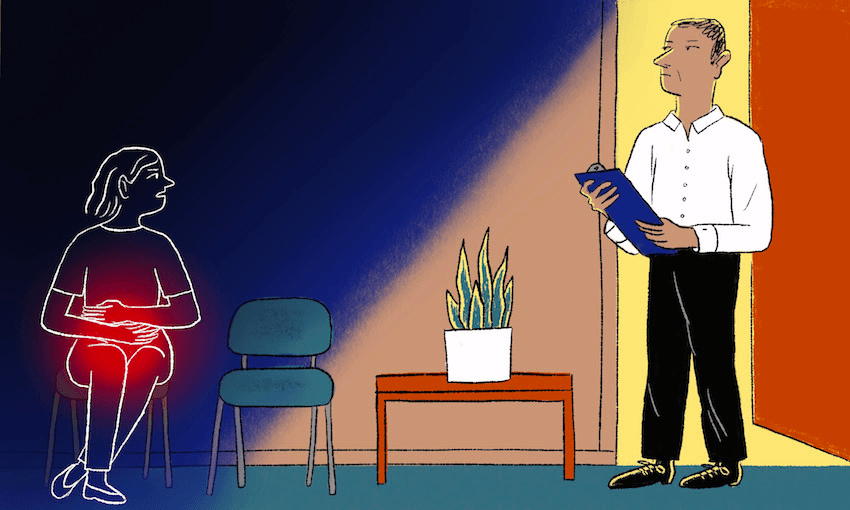I assumed I would be better the next day or the next week. I wasn’t.
The Sunday Essay is made possible thanks to the support of Creative New Zealand
Original illustrations by Sophie Watson
2009
I’m living in the Dominican Republic, working with kids living in extreme poverty. In my spare time I make friendship bracelets with the kids, eat ice cream and dance to reggaeton.
On a work trip to Central America I get a fever, severe back pain and diarrhoea. I assume I’m in pain from sleeping on a plastic kids mattress for a year.
A week after returning to the DR, I’m diagnosed with amoebas and all sorts of parasites and given kids medication. Every time I eat, the abdominal pain is so severe that I lie down, curl up into a ball and roll around crying. The doctor reassures me that it’s just the amoebas.
I’m no medical professional but I’m pretty sure that daily stabbing abdominal pain, nausea, pain during sex, diarhhoea six times a day, back and neck pain, headaches and fatigue are not normal.
I assume I’ll be better tomorrow or next week. It lasts 11 years.
2011
I come home to Aotearoa 10 kilos lighter and receive compliments on how well I look. One old friend says he’d heard that I’d gotten “all skinny and sexy”.
Soon enough malabsorption kicks in, meaning I can’t properly absorb all the nutrients from the food I eat. I put the weight back on and the compliments stop.
I spend my savings on doctors, tests, medicine, supplements, electrolytes, treatment plans, therapy and specialist appointments. With all that money I could have bought a whare, or at least a really nice car.
While my pain worsens, my meditation and yoga practice gets stronger, stopping me from completely losing hope.
2017
It takes six years but eventually my GP sends me to a gastro specialist for a colonoscopy. I am so excited to finally get some answers.
After the surgery I’m told that I don’t have cancer or chron’s, and am instead diagnosed with IBS, which the specialist explains is the diagnosis given for gastrointestinal issues when there is no other clear diagnosis. When I ask what she can offer to help manage my chronic abdominal pain, diarrhoea and fatigue, she recommends that I take imodium everyday – an anti-diarrhoea pill. I sit in her office, crying, and when I ask if there’s anything else she can do, she offers to write a prescription for depression meds despite the fact that I’m not depressed. Yet.
Soon enough, I return to my GP as fatigue is making it hard for me to function. After years of trying to help, he suggests that I go on the sickness benefit. I can’t give up my work supporting rangatahi with The Kindness Institute. My limited energy goes into it and I feel guilty for not having time for my friends or whānau. And I’m resentful that almost every time I have more than two or three beers I feel like shit for weeks.
My good friends are incredible and without them, my mum, my mother-in-law, my therapist and my boyfriend, I wouldn’t get through it. My boyfriend sacrifices almost all of his free time to take care of me.
2018
Ten years in, my work is going better than ever. I’ve started The Kindness Institute and we’ve worked with so many incredible youth through our mental health kaupapa. I receive the order of merit and around the same time things take a turn for the worse with my health.
I end up in A&E with 10/10 abdominal pain and I am turned away because they’re “full and closing soon”. I’m in agony for weeks. I don’t have the energy to write a formal complaint but don’t worry Auckland DHB, it’s coming.
2019
I become hapu and go through a painful pregnancy loss. The pain lasts for months and I become depressed – grieving the loss of the baby and taking a massive physical hit. I’m unable to do much other than sleep, and I feel trapped in my body. It takes about six months until I can go for a walk and not double over in pain.
I end up having around three days a month when I can function normally. The rest of the time I’m in pain and largely bed-bound. After seeing countless doctors, I see two naturopaths when I’m just about at breaking point. One fat shames me and the other fully invests in my recovery and recommends I get a laparoscopy to see if I have endometriosis. Endo is an inflammatory disease that can include period pain, pelvic pain, bowel problems and sub-fertility or infertility. Sometimes endo can be misdiagnosed as other conditions, like IBS.
2020
I find a gynaecologist and the gynaecologist finds stage three, going on stage four, endometriosis throughout my organs. I can’t believe it. After 10 years of no concrete answers, I am diagnosed with endo and told that my health has been seriously mismanaged.
The recovery is hectic and the pain seems worse than before. The pain medication makes my brain feel weird. I can’t do the smallest tasks like put on my socks. My boyfriend’s had to take weeks off work to care for me and I am, once again, pretty depressed.
Three months after the surgery, I’m so excited when I get hapu again but it leads to another miscarriage. Things aren’t perfect, but eventually I start to get my energy back and feel much better. Cutting gluten, dairy and soy helps, but costs a fortune finding the right specialists – nutritionist, therapist, naturopath and physical therapist just to manage the disease.
I try CBD oil and it’s the only thing that lowers my pain without any side effects.
I’m fortunate to be able to advocate for myself and to have shitloads of support, yet it still took me 11 years, my life savings and private health insurance to get a diagnosis.
2021
After all these years and two miscarriages, I give birth to a beautiful baby girl. While I’m hapu, all my endo symptoms completely disappear. Even though the disease is one of the leading causes of infertility, women have to wait years for surgery and don’t receive any ongoing care.
2022
As a girl I was told that pain during sex is normal (it isn’t) and that period pain is simply part of being a woman.
No one taught us in school that if your period pain shouldn’t stop you from doing everyday activities. According to Endometriosis NZ, It still takes more than eight years to get a diagnosis from first presenting with symptoms. Lots of wahine might think that their symptoms are normal, and be too whakamā to seek help or be misdiagnosed.
Early on, a friend suggested that I might have endo, but that doctors dismissed it because my periods were regular. I met a lot of lovely health professionals along the way but not many who looked beyond the IBS diagnosis.
One in ten women suffer from endometriosis, that’s roughly 190 million women worldwide. According to Endometriosis NZ, 27% of girls aged 13-18 years are absent from school in Aotearoa, because of distressing symptoms relating to their period. Early intervention is essential as menstrual disorders in rangatahi can have a significant impact on their physical and mental health and seriously compromise schooling, quality of life and future fertility.
2022
My health isn’t perfect and some of the pain is back, but I feel better than I have in years. After more than a decade of being told that I had no reason to feel the things I was feeling, I’m still learning to trust my body.
Love The Sunday Essay series? Be sure to check out The Sunday Essay postcard set over in The Spinoff shop. The set includes 10 original illustrations from the series with insight from the artists.




